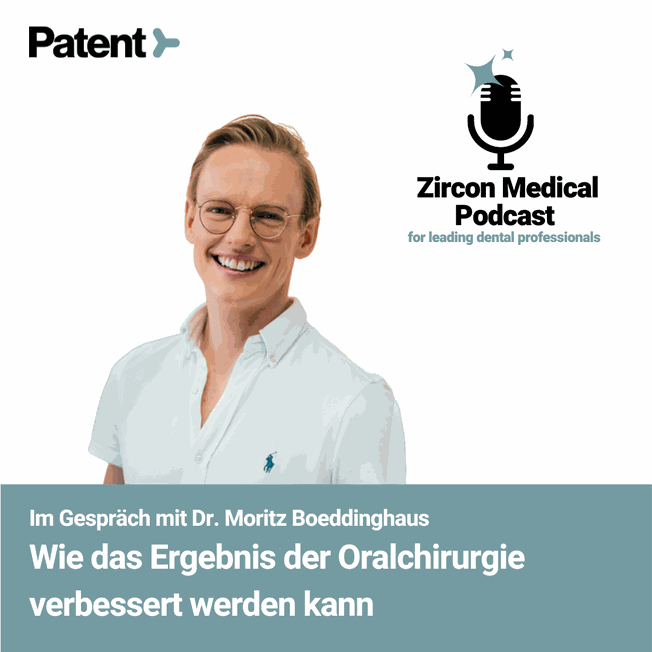
The value of autologous socket preservation with PRF instead of bone replacement materials
The value of optimal prophylaxis training before dental implant surgery
The value of digital volume tomography (DVT) for dental implant surgeries
The dangers of performing implants without sufficient specialization and training
A word of caution about minimally invasive dental implants
The need for transparency in the field of dental implants
Dr. Moritz Boeddinghaus
Dental Surgeon at "Dr. Boeddinghaus - Fachzahnärzte am Eickeler Park"
Passed his state examination in 2013
Completed his residency in oral surgery in 2018
Runs his own dental practice called "Dr. Boeddinghaus - Fachzahnärzte am Eickeler Park"
Location: Reichsstraße 31, 44651 Herne, Germany
Instagram: @dr_boeddinghaus
Phone: +49232531136
Youtube: https://www.youtube.com/channel/UCuXBpJxteG5c9RWORMaodHQ
LinkedIn: https://www.linkedin.com/in/dr-moritz-boeddinghaus-92785a1a5/
Reichsstraße 31, 44651 Herne, Deutschland
In Conversation with Dr. Moritz Boeddinghaus
When performing oral surgeries or dental implants, dentists have to consider numerous factors. They have to consider whether they need bone grafting or sinus lifts if they need to worry about periodontitis, how much they can rely on digital volume tomography (DVT), and much more. Dr. Moritz Boeddinghaus is an oral surgeon from Herne with very strong opinions on the current state of oral surgery and its future.
Our team at Zircon Medical recently hosted Dr. Boeddinghaus on our podcast series to discuss how to improve the outcome of oral surgery.
Introducing Dr. Moritz Boeddinghaus, the dental surgeon at Dr. Boeddinghaus - Zahnarzt & Oralchirurg
Dr. Moritz Boeddinghaus is the leading oral surgeon and owner of a practice called Dr. Boeddinghaus - Zahnarzt & Oralchirurg, located in Herne. His dental practice provides all kinds of dental services, but he specializes in oral surgery, having completed a residency in 2018.
Dr. Moritz had initially considered entering the field of human medicine, but he eventually specialized in dentistry because it seemed practical, and he enjoyed his dental courses in university. He had always been drawn to surgery, but oral surgery eventually crystallized as his primary interest. He continued his training in oral surgery and eventually gained independence within the field once he took over his father’s practice.
Dr. Moritz’s father is still at the dental practice, but they’ve switched roles, with the younger Boeddinghaus now taking the reins. “I'm glad he's there,” Dr. Moritz says. "That's really good support because you have someone who has been doing this for a long time. There are also sub-areas where my father can help me well. It’s not bad to have a partner who can fall back on almost 40 years of experience.”
Dr. Moritz also emphasized that his father’s presence doesn’t diminish his own experience and skills. If he brings his father in for a consultation, his patients are glad to have two sets of eyes on them instead of one, but it doesn’t undermine his authority. To that end, Dr. Moritz believes that if a dental practice has multiple dentists, they should actively collaborate with each other — that can really benefit the patients.
Dr. Boeddinghaus - Zahnarzt & Oralchirurg has a total of 13 employed assistants because they have a large focus on prophylaxis, but they intend to expand on the medical side over the coming years. They’re rebuilding the practice to increase its space three or four folds in anticipation of its future possibilities.
The value of autologous socket preservation with PRF instead of bone replacement materials
As mentioned previously, Dr. Moritz’s practice specializes in oral surgery, and 50% of them are for dental implants. When it comes to socket preservation after teeth extraction, most dentists use bone replacement materials. However, Dr. Moritz prefers using PRF (platelet-rich-fibrin) for socket preservation because it guarantees more predictable healing and results. He backs this claim with observations from his time in university.
While Dr. Moritz was in university in Mainz, he was a part of a small study that performed numerous socket preservations with bone replacement materials, and it didn’t work very well. This observation would follow him into practice — he made this same observation over and over again with his patients. That’s when he realized socket preservation can be performed with consistent and better results if you use the patent’s own blood via platelet-rich fibrin.
Dr. Moritz is also against the use of bone replacement materials because of the risk of residual inflammation. He says there have been cases wherein their sourced bone replacement materials contained residual inflammation despite good curettage. Upon using the material for socket preservation, the residual inflammation somehow transformed in the patient, leading to chronic pain conditions after two or three months.
Because of these risks, Dr. Moritz avoids bone substitute materials during socket preservation. Of course, Dr. Moritz concedes that some cases necessitate bone augmentation, such as a sinus lift. But when he’s working with smaller problems, such as when a little bit of the thread is exposed, he uses a scraping tool to extract a little of the patent’s own bone and secures it with a PRF membrane. He’s a huge proponent of autologous treatments.
Besides the safety and functional aspects of autologous socket preservation, Dr. Moritz says his technique is also relatively cheaper. He says he extracts the patient’s healthy bone tissues using a small scraping tool with the thickness of a pencil, which costs around 50 euros. Meanwhile, the cost of a small pack of bone replacement materials is 100 euros, and the cost of membranes is another 100 euros. That’s four times the cost of autologous socket preservation.
The value of optimal prophylaxis training before dental implant surgery
Dr. Moritz advocates that all patients should be trained in optimal prophylaxis training before implantation. His dental practice has a special prophylaxis concept called Solo Prophylaxis, which his father had been doing for over 15 years. It focuses on helping the patient establish optimal oral hygiene habits, such as cleaning the interdental spaces while overcoming their mental barriers to regular flossing and oral health.
What is Solo Prophylaxis?
Dr. Moritz says solo prophylaxis starts with regular teeth cleaning, similar to professional teeth cleaning. He advises his patients to concentrate on the interdental spaces and the necks of the teeth because that’s where caries usually occur. The smooth surfaces of the teeth are usually subject to self-cleaning, so they don’t require as much attention. The patient’s teeth are also measured for accuracy.
After the assessment, the patient receives brushes with 3 to 4 different sizes, adjusted according to the specific measurements of their interdental spaces. The patient also receives a dental plan that they can hang on their bathroom mirror, allowing them to see which brush size and technique to use in which area. The process shouldn’t take much longer than regular toothbrushing once the patient is used to the technique.
Stopping Inflammation
When patients try the new brushing technique for the first time within the dental practice, they inevitably experience mild bleeding because of small inflammations. Dr. Moritz says patients have to be counseled through that experience — they need to be told that they’ll continue bleeding for another week or two because of the inflammation. If they continue this routine, the bleeding will abruptly stop after a week or two.
Dr. Moritz says the point when they stop bleeding is when they start trusting you wholeheartedly. Since they’re told in advance that bleeding is a sign of inflammation, the lack of bleeding makes them realize that they’re no longer inflamed. At that point, Dr. Moritz says the patient might say something like, "I feel much better, the mouth stays fresh much longer in the mouth, and I have a fresh feeling.”
According to Dr. Moritz, Solo Prophylaxis is a complete paradigm shift for the patient away from normal tooth brushing. He acknowledges that some of his techniques may sound hardline, but his dental practice has been following this standard for over 15 years, and they have the first-hand experience of how dental restorations and fillings last longer if patients follow these techniques.
Preventing Periodontitis
The solo prophylaxis technique improves the patient’s candidacy for oral surgery because it reduces the risk of periodontitis, the primary cause of bone loss. Dr. Moritz says most patients start experiencing periodontitis by their 20s or 30s, and that continues for most of their adult lives until they experience severe bone loss in their 50s and 60s, necessitating dental implants.
Dr. Moritz contests the commonly-touted phrase “age-related bone loss.” He says there’s no such thing as age-related bone loss, only bacteria-related bone loss. Patients usually start developing early periodontitis in their 20s and 30s, which continues until later in life and causes bone loss. This gives the impression that bone loss is a natural consequence of age, but it can be avoided with proper oral hygiene and prophylaxis.
Preserving Natural Teeth
Solo prophylaxis prevents periodontitis and stops chronic bone loss, which improves the longevity of dental restorations and prevents tooth loss. As such, solar prophylaxis actively helps patients preserve all of their teeth instead of needing dental implants.
Dr. Moritz says older patients generally have 15 or 20 teeth with a looseness grade of 2. This can be a good opportunity for a dental surgeon — they can recommend removing all the teeth and placing dental implants. But that’s not ideal for patients who would like to preserve their natural teeth instead. Dr. Moritz focuses on helping patients preserve their teeth and recommends implants only when absolutely necessary.
The value of digital volume tomography (DVT) for dental implant surgeries
As the field of oral surgery moves towards the future, computer-assisted navigation systems are becoming more and more commonplace. However, Dr. Moritz voices concerns over the current state of automation.
Dr. Moritz says they use a digital volume tomography (DVT) device in their practice, but they limit its application and only use it for mild guidance. At the moment, he says DVTs aren’t 100% reliable. Furthermore, he’s not yet comfortable handing over the drill to a robot — the technology still has some way to go before they can be comfortable with complete automation.
While Dr. Moritz acknowledges the value and potential of DVT, he says he’s fairly conservative despite his age. He has a similarly ambivalent approach to technology in general. He acknowledges that technology is necessary for progress, but, on the flip side, it simplifies everything and reduces the barrier for entry. Complex cases and procedures become mainstream and easy, so dental professionals without sufficient experience feel comfortable dabbling in them.
Dr. Moritz believes it’s important to strike the right balance — acquire the advanced technologies, but still master the basic knowledge even if you believe it’s not necessary. He goes a little further and questions the ethicality of performing implants without cutting, a dangerous development propelled by advanced technologies and led by dentists who perform implants without specializing in oral surgery.
The dangers of performing implants without sufficient specialization and training
Dr. Moritz cautions against a development that’s been creeping up for several years — dentists using advanced technologies to perform implants without oral surgery. According to him, this has led to a poor standing with patients in implantology. He is also against dentists who might specialize in oral surgery but only do a few implants occasionally. He believes implants should only be placed by dentists with specialized training in oral surgery and those who perform a large number of implants on a regular basis.
Dr. Moritz compares implants to wisdom tooth extraction. He says it’s frowned upon for a dentist to perform wisdom tooth extractions every now and then if they don’t do it regularly. That’s because it increases the risk of complications or mistakes. And implantology is no different. If a dentist doesn’t place implants with utmost precision, it can lead to poor outcomes for the patient. The only difference is that the patient must pay for the implant from their own pocket, so they’re even more displeased when it goes wrong.
Placing an implant incorrectly can also damage the neighboring structures, leading to additional damage caused by the selective intervention. If a dentist doesn’t specialize in implants, they might hit the nerve or place the implant such that it falls out after a few years or cause excessive bone damage. These are only some of the many possible risks of incorrect implants. Dr. Moritz believes the field of dental implantology can’t be learned over a weekend course — it must be practiced and honed over several years.
A word of caution about minimally invasive dental implants
Dr. Moritz provides an example of minimally invasive implants, also known as short implants, to illustrate his point further. According to him, short implants are extremely beneficial because they don’t involve complex surgeries, the implant can be inserted with minimal bone supply, and there’s no need for gum incisions. If the case is correct, dentists can and should go for minimally invasive dental implants.
However, Dr. Moritz cautions that the purpose of short implants isn’t to make it easier for more dentists to place implants. If a dentist provides short implants, they must have sufficient experience with regular implants, as well. Even if the dentist doesn’t need to cut or make incisions, they should still have a strong feeling for the bone and the capacity to manage potential complicators or errors.
Dr. Moritz believes the Implantology industry will hurt itself if the barrier to entry is lowered significantly. Dentists who don’t like surgeries or opening up might start providing implants, even when that’s not the best option for the patient. This could lead to potential complications and poor outcomes, which will affect the general reputation of the implantology industry, preventing patients from seeking implants.
Similarly, Dr. Moritz believes that dental professionals should only perform mini implants if they’re also confident in their ability to perform traditional implants. The same logic applies to other fields of oral surgery, such as a sinus lift. Doing an internal sinus lift might be easier, but a dentist should only attempt it if they’re also completely comfortable and experienced with external sinus lifts.
The purpose of simpler procedures should be to improve the patient’s outcome, not making it simpler for dentists.
The need for transparency in the field of dental implants
Dr. Moritz believes dentists don’t talk about their concerns and failures openly enough. According to him, most dentists say everything is going perfectly for them, refusing to voice their personal mistakes and struggles. “The best way to learn is through mistakes,” he says, acknowledging that one can learn a lot from their own mistakes. However, he also goes further, stating that the ultimate goal should be to “teach your own mistakes to others, preventingthem from making mistakes.”
While most dentists learn from their own mistakes, Dr. Moritz believes not enough dentists are willing to teach others about their mistakes. He acknowledges that discussing your mistakes can make you vulnerable, and it’s natural to fear that others might think you’re a bad dentist for making such mistakes. However, Dr. Moritz says those who talk about their mistakes are more likely to reflect on them and grow.
Dr. Moritz Boeddinghaus is extremely accessible, both online and offline. You can find him in his dental practice at Reichsstraße 31, 44651 Herne, or you can follow him on LinkedIn, Instagram, or YouTube. You can also listen to him in our Zircon Medical podcast or continue reading for a detailed article on Solo Prophylaxis, which was touched upon earlier in this article.
Register for our free newsletter.
Never miss one of our weekly episodes with leading dental professionals.
What is Solo Prophylaxis?
An independent article by the Zircon Medical Team
Most people realize that regular toothbrushing and flossing aren’t enough to prevent tooth decay, cavities, and gum disease. That’s why it’s recommended for everyone to seek regular professional dental cleaning. Without regular professional dental cleaning, patients have a high risk of inflammation and gum disease, which can increase the risk of heart attack, strokes, respiratory disorders, diabetes, bone loss, tooth loss, and much more.
However, convincing patients to seek professional teeth cleaning once or twice every year is difficult. Most of them don’t see the value in regular teeth cleaning, especially since the early signs of mild inflammation aren’t obvious. Solo prophylaxis is a means of helping patients maintain optimal oral health with at-home oral hygiene, liberating them from a dependence on annual or bi-annual professional teeth cleanings.
Solo prophylaxis involves using a much smaller toothbrush, available in a wide range of sizes. The dentist accurately measures the patient’s interdental spaces to recommend the ideal range of brush sizes. The motion used to clear teeth using the solo prophylaxis kit is also different, which is why dentists must actively help their patients through the transition. The interproximal brush effectively removes all the bacteria and plaque from the interdental spaces of the teeth.
The solo prophylaxis kit also includes special tools for cleaning the smooth surfaces of the teeth and preventing decay from forming within fissures. Traditionally, patients opt for professional sealants to prevent bacterial decay within their natural teeth fissures. But solo prophylaxis consists of at-home sealants that can close the fissures, minimizing the risk of decay forming within them.
Solo prophylaxis removes bacteria and plaque from the interdental spaces and the neck of the teeth, closes the fissures to minimize the risk of decay, and cleans the smooth surfaces of the teeth. As such, it helps patients maintain optimal oral health, thereby improving the longevity of their restorations and minimizing the need for implants and teeth replacement later in life. However, patients need dentists to adopt this brushing technique because it goes against everything they’re used to.











